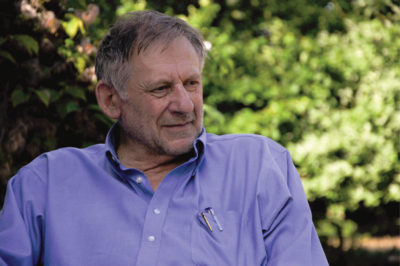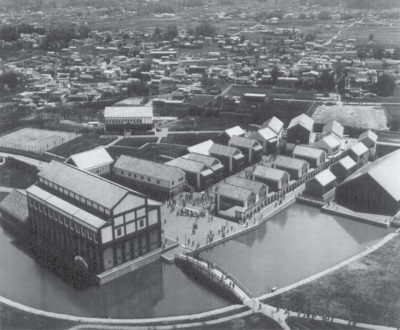“Really one of the very largest problems that is facing the Earth just now, is rarely mentioned—and that is the spread of ugliness.”
“Everything that we see in our surroundings—everything—either slightly raises our spirits or slightly lowers them.”
 Christopher Wolfgang John Alexander died March 17, 2022, at his home in Sussex, England, of pneumonia, after a long illness. He was 85. As befits his extraordinary life and influential body of work, his passing was noted with long and informative obituaries in the NY Times, The Guardian, most major architectural journals, and elsewhere. As I argued in three columns for the The American Surveyor (Christopher Alexander, Genius of Space; Life, the Nature of Order, and Everything; and The Process of Creating Life) in 2004 and 2005, his theories about land use, architecture and construction, and urban planning are—or should be—of great interest to land surveyors, especially those involved, at any level or scale, in conceptual development of municipalities, subdivisions, or new construction… which is most of us, no?
Christopher Wolfgang John Alexander died March 17, 2022, at his home in Sussex, England, of pneumonia, after a long illness. He was 85. As befits his extraordinary life and influential body of work, his passing was noted with long and informative obituaries in the NY Times, The Guardian, most major architectural journals, and elsewhere. As I argued in three columns for the The American Surveyor (Christopher Alexander, Genius of Space; Life, the Nature of Order, and Everything; and The Process of Creating Life) in 2004 and 2005, his theories about land use, architecture and construction, and urban planning are—or should be—of great interest to land surveyors, especially those involved, at any level or scale, in conceptual development of municipalities, subdivisions, or new construction… which is most of us, no?
Known primarily as the author of A Pattern Language (published in 1977, and believed to the best-selling architectural book of all time) and his magnum opus, the four-volume The Nature of Order, and as the designer (and often builder) of about 200 works, ranging from the small-but-charming, e.g., a near perfect concrete bench tucked away near San Francisco’s Fort Mason, with a fine view of Alcatraz, to the quite large, e.g., the Eishin Campus, near Tokyo, a combined high school and college campus, nine city blocks in size for 2,000 students—now considered something of a miraculous modern emergence of classic beauty and structure, the design and realization of Eishin was 30-year struggle against corrupt officialdom and rigid commercial strictures, ultimately involving literal arm wrestling, and even Yakuza (a struggle described by Alexander in his important and remarkable true life architectural adventure book, The Battle for the Life and Beauty of the Earth).

The Eishin Campus, near Tokyo, a combined high school and college campus, a nearly 30-year project of Christopher Alexander, as developer, architect, and sometimes builder.
Via this body of work, and from direct university teaching and by his founding of the Center for Environmental Structure, Alexander was consciously trying to change the minds—and hearts—specifically of architects, planners, and builders, but along the way he gained a substantial following in many fields, for example software programming, permaculture, and interior design.
Specifically among land surveyors though… not so much, or at least not detected by me in 30 years engagement with surveying as career and as subject of my writing—and for much of that time I have been a part-time, unpaid evangelist for Alexandrian ideas! It seems a shame, more so because Alexander himself, by 2004 at least, had identified land surveyors as an important, even foundational, member of the forces he sought to rouse to combat ugliness in what he saw as the “battle for the life for life and beauty of the Earth”. I know this to be true because he told me so himself.
Alexander on Land Surveyors

Early days at Eishin, demonstrating Alexander’s nearly unique ability to design, and see built, complexes that sit lightly on the land while creating “living” and beautifully functional space.
I interviewed Alexander in 2004—by phone of course, as he was in England and I was in Wisconsin—and it was certainly a thrill; I was just beginning my career as a freelance infrastructure writer and the idea that I could obtain time with a giant of architecture and building, and one of my longtime intellectual heroes, simply by asking for it by email was a staggering revelation.
Even more surprising, it turned out Alexander had questions for me; he had begun planning the development of Harbor Peak, a large plot of land in the hill above Brookings, Oregon, and had come to realize that the initial topographic surveying of the land was not only of vital importance to planning and mapping, but was possibly the first important step of the process for planning and development that he believed to be essential in order to respect the land and its existing beauty, and to increase the life and comfort of future residents.
From the interview:
“I have a special interest in surveying, for a reason that will take me a moment to explain. When you layout even a building or certainly a group of buildings or a community, the way to successfully involve people, and more important than that the way to make the results come out harmoniously with the land is to work the thing out and ultimately place stakes, even of the initial layout, as you see them and feel them in the land. We can certainly go into why I believe that to be the case, but if I may, just for the moment get to the surveying part I would like you just to accept that that’s my opinion.”
And so, I became the interviewee for the bulk of the interview, and he the interviewer. Two facts were quickly apparent:
1) Like many, maybe most, architects, Alexander didn’t know much about what surveyors actually do, or how we work. For example, he seemed to believe that surveyors still worked with theodolites, or a sextant or something, and that topographic mapping was still a tedious, manual process. This was in 2004, remember, and it was with some bemusement that I explained the ready availability of total stations, and of CAD software that could rapidly import hundreds of tagged X,Y,Z coordinates.
Angus: “Well we work with what’s called a total station that uses infrared to measure distance precisely and it’s routine for us to capture precisely within a few hundredths of a foot the location of hundreds of points in a day.”
Alexander: “Measure distance precisely!?”
2) More importantly, Alexander did have a deep understanding of subdivision planning, where it went wrong (in his view), and what needed to be done differently—by developers, planners, surveyors, etc.—to make the world better and more beautiful, rather than uglier.
Alexander: “Subdivision maps are a torment to the land, as you probably know… Much of it done by a developer who doesn’t want to spend a penny more than he has to. When I say they are a torment to the land, it’s because most of it is conceived barely in relationship to the land—it is really like an overlay. As you know there is a lot of bulldozing that goes on because people don’t want to screw around with the complexities of actual land, adapting lots and buildings and boundaries and out buildings and so forth, to land in an organic and comfortable fashion. It’s a mindset that virtually does not exist now, but was completely commonplace everywhere in the world up until a hundred years ago.”
Alexander was just then beginning to write what became The Master Plan and Process for Harbor Peak.
Alexander: “Right down near the California border there is a place called Brookings, Oregon, and Harbor Peak is in the hills just above Brookings so it looks out over the ocean but it is inland about a half a mile. Anyway, we’re doing a completely new kind of master plan for this community, where the whole subdivision process and the layout process is governed by the kind of thinking that we’re talking about here. It’s the first time that I ever attempted to write a full legal description of what it takes to do things in this way, although I have been doing it in practice in many projects for years. But it is quite fascinating, and I think if you’re writing an article with that orientation in some ways I’d like to get bits of this master plan to you. The trouble is that we’re right in the nitty gritty of fooling around with the language. But I feel enormously encouraged, in fact very, very excited by the fact that you immediately pinpointed mind set as being the critical issue. Of course, these things are not technical wonders, it’s primarily a question of whether the developer or the township or the planning officials, architects, contractors are interested in being in that kind of relationship to a piece of land so that it’s in harmony with the land it protects the land it preserves the structure of the land and makes something beautiful out of it. One of the reasons why I have been so concerned with this surveying problem is that I think that it’s a major key to helping people to think in this way, even when they think that it is not possible.”
Well, it was he, not me, who “immediately pinpointed mindset as being the critical issue” and it’s taken me nearly 20 years to write something like the article he envisioned, but here you go Chris—sorry it took so long.
The Master Plan and Process for Harbor Peak

The Eishin Campus, is now recognized—and revered by students—as a reemergence of classic scholastic design.
Master Plan and Process is an interesting and important attempt by Alexander to codify his ideal subdivision development process in language that could satisfy state and local officials, while also making it possible for owners, developers, and residents to identify, preserve, and enhance naturally occurring “centers”—Alexander’s term for loci that are “spots of living beauty in the land.” To perhaps too brutally summarize a long and intricate document, he does this by formally describing a gradual, iterative process whereby centers are initially determined by owners simply walking about and marking them—“As one walks about the land, you encounter different spots, each with its natural beauties. One is a view of the snow-covered peak to the south. One is a breathtaking view of the cost south of Harbor, and the surf. One is a flat place on a ridge, narrow but commanding, with steep slopes dropping off on either side. Another is an open meadow; another a small patch of flowers; another a naturally occurring waterfall.”
And then continues, step-by-step, to establish lots, roadways, building volumes, neighborhoods, etc., not by the imposed “torment,” in one fell swoop, of the preliminary plat but by gradual occupation, planned and approved in stages.
Bound copies of Master Plan and Process, Near Brookings Oregon, A Model Creation Process for 21st Century Cities (to give it it’s full title) are rare and expensive now, but a free PDF is readily available online, and I believe should be included in the library of every survey office, if only as an eloquently expressed alternative to current planning and development methods. And full disclosure, I had some small influence on Master Plan and Process, e.g., this section:
1.8 Required Surveying Techniques: Total-Station Surveying as Fundamental to the Process of Establishing Planned Locations of Field-Defined Configurations
At least, he heard the term ‘total station’ from me, and it’s gratifying that he directly addressed the role of surveyors in his message for the world.
I don’t blame readers of this article if it all seems, simultaneously, a bit much and too little; a writer like Alexander who unironically includes words like beauty, joy, organic evolution, harmony, and even religion and soul and God, in a planning document, is expecting a lot of developers and surveyors just trying to make a living, and probably providing too little to satisfy the ninnyhammers on the Planning Committee. And for the record, an extensive search online suggests that Master Plan and Process was not adopted in Oregon; I hope I’m wrong.
But consider a nice turn of phrase spoken by Alexander to eminent architect and writer Witold Rybcynski, in conversation; “Everything that we see in our surroundings—everything—either slightly raises our spirits or slightly lowers them.” Put like this, the proposition that surveyors—who by the nature of our work are creating much of what “we see in our surroundings”—have the opportunity, and perhaps responsibility, to ‘raise the spirits’ of ourselves and, well, everyone else, seems inarguably true.
Anyway, why not download a free copy of Master Plan and Process, read it for yourself, and see what you think?
Angus W. Stocking is a former licensed land surveyor who has been writing about infrastructure since 2002.